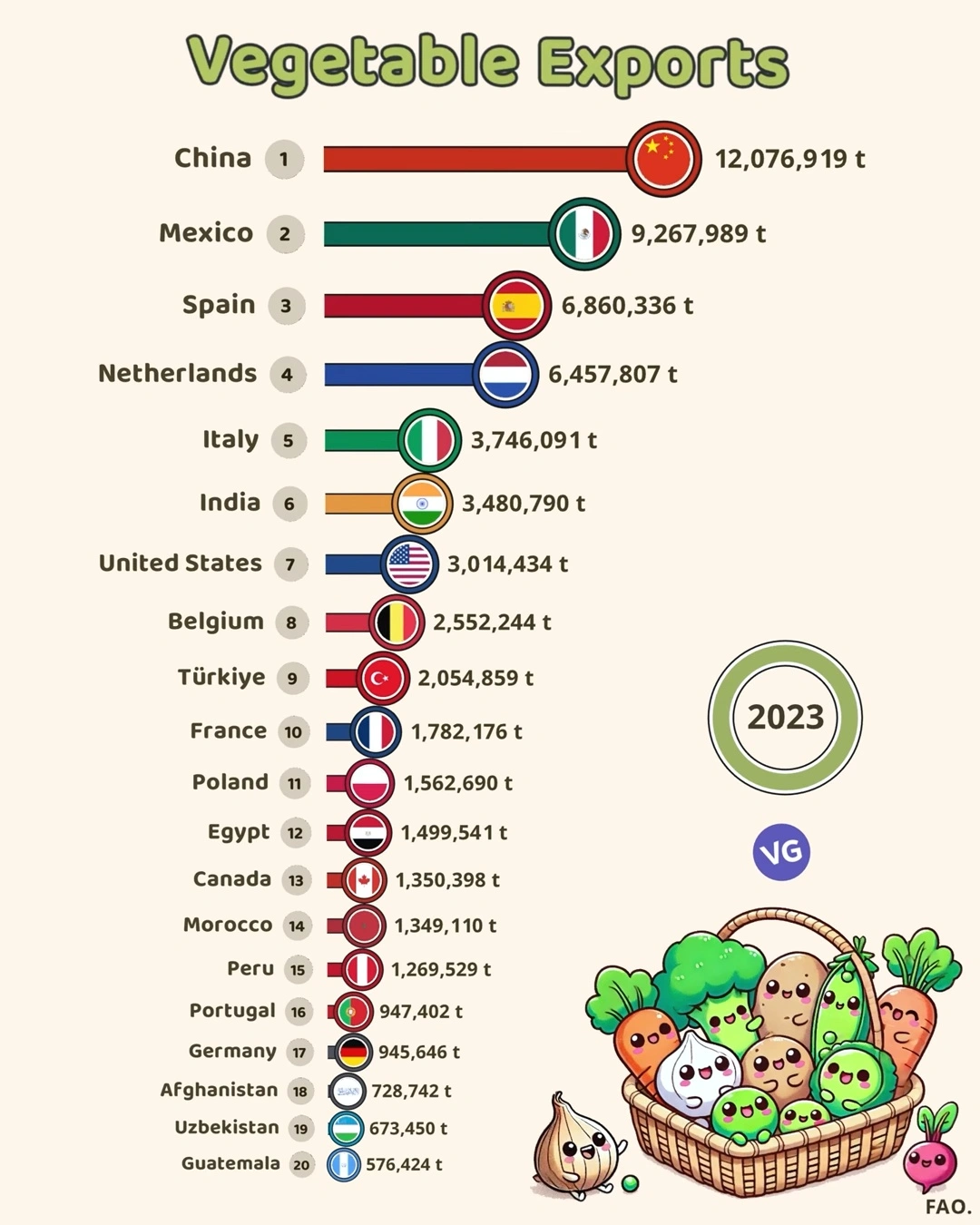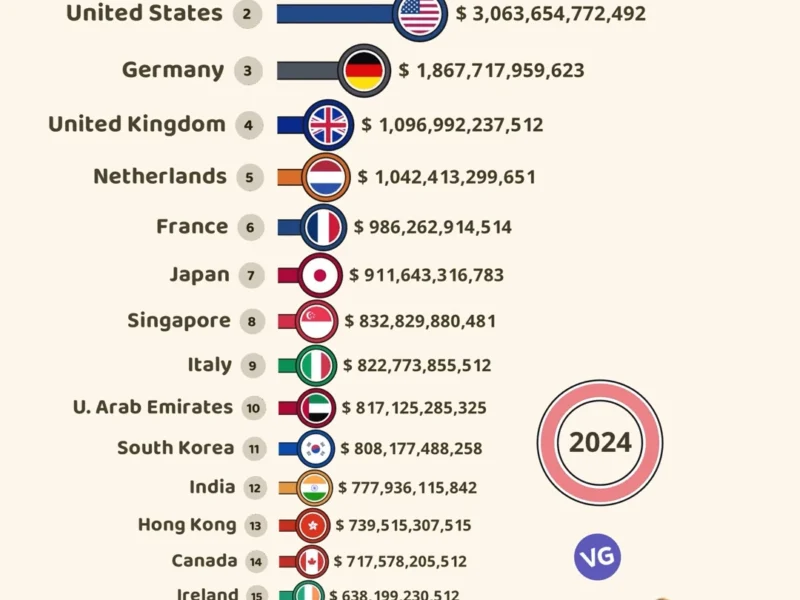The international vegetable trade represents a vital component of global food systems, ensuring year-round access to fresh produce across different regions. According to 2023 data from the Food and Agriculture Organization (FAO), the global vegetable export landscape reveals fascinating patterns of agricultural specialization and trade efficiency.
Top Countries by Vegetable Exports (2023)
| Rank | Country | Export Volume (t) |
|---|---|---|
| 1 | 🇨🇳 China | 12,076,919 |
| 2 | 🇲🇽 Mexico | 9,267,989 |
| 3 | 🇪🇸 Spain | 6,860,336 |
| 4 | 🇳🇱 Netherlands | 6,457,807 |
| 5 | 🇮🇹 Italy | 3,746,091 |
| 6 | 🇮🇳 India | 3,480,790 |
| 7 | 🇺🇸 United States | 3,014,434 |
| 8 | 🇧🇪 Belgium | 2,552,244 |
| 9 | 🇹🇷 Türkiye | 2,054,859 |
| 10 | 🇫🇷 France | 1,782,176 |
| 11 | 🇵🇱 Poland | 1,562,690 |
| 12 | 🇪🇬 Egypt | 1,499,541 |
| 13 | 🇨🇦 Canada | 1,350,398 |
| 14 | 🇲🇦 Morocco | 1,349,110 |
| 15 | 🇵🇪 Peru | 1,269,529 |
| 16 | 🇵🇹 Portugal | 947,402 |
| 17 | 🇩🇪 Germany | 945,646 |
| 18 | 🇦🇫 Afghanistan | 728,742 |
| 19 | 🇺🇿 Uzbekistan | 673,450 |
| 20 | 🇬🇹 Guatemala | 576,424 |
The Leading Exporters
China dominates the global vegetable export market with 12,076,919 tonnes shipped in 2023. This impressive figure reflects China’s massive agricultural capacity, diverse growing regions, and strategic focus on horticultural exports. Chinese vegetable exports range from garlic and ginger to mushrooms and various leafy greens, serving markets worldwide but particularly across Asia.
Mexico holds a strong second position with 9,267,989 tonnes, benefiting from its proximity to the United States – the world’s largest vegetable importer. Mexican exports focus heavily on tomatoes, peppers, cucumbers, and avocados, with production concentrated in regions that can supply the North American market when domestic production is limited by seasonal factors.
Europe’s Strong Presence
European nations feature prominently in the rankings, with Spain (3rd at 6,860,336 tonnes) and the Netherlands (4th at 6,457,807 tonnes) showing particularly impressive numbers. Spain leverages its Mediterranean climate to produce vegetables year-round, with significant exports of tomatoes, peppers, cucumbers, and lettuce primarily serving Northern European markets.
The Netherlands’ high ranking is especially remarkable given its small geographic size. Dutch vegetable exports reflect the country’s world-leading greenhouse technology and agricultural efficiency. The Netherlands serves as both a major producer (particularly of greenhouse vegetables) and a crucial trade hub, re-exporting produce from other regions.
Specialized Production Regions
Several countries on the list have developed specialized vegetable export niches:
- Belgium (8th with 2,552,244 tonnes) has particular strength in exports of leeks, Brussels sprouts, and chicory
- Morocco (14th with 1,349,110 tonnes) specializes in tomatoes, peppers, and beans for European markets
- Peru (15th with 1,269,529 tonnes) has developed strong exports of asparagus, artichokes, and peppers
- Afghanistan’s presence on the list (18th with 728,742 tonnes) highlights its important exports of onions, potatoes, and other root vegetables to neighboring countries
Geographical Patterns and Climate Advantages
The data reveals how vegetable exports often follow patterns based on:
- Climatic advantages – Countries with Mediterranean climates (Spain, Italy, Morocco) or tropical/subtropical conditions (Mexico, Guatemala) can produce vegetables when temperate regions cannot
- Technological innovation – Nations like the Netherlands and Belgium leverage advanced greenhouse systems to overcome natural climatic limitations
- Labor cost advantages – Several countries benefit from comparative advantages in labor-intensive vegetable production
- Proximity to major markets – Mexico’s strong position relates directly to its border with the United States
Unexpected Contenders
Some unexpected countries in the top 20 highlight the evolving nature of global vegetable trade:
- Afghanistan’s ranking demonstrates how agricultural exports remain crucial to developing economies despite challenging circumstances
- Uzbekistan (19th with 673,450 tonnes) shows Central Asia’s growing integration into global agricultural trade
- Guatemala’s presence (20th with 576,424 tonnes) reflects Central America’s increasing role in supplying the North American market
Economic and Food Security Implications
These export figures represent significant economic value beyond the tonnage indicated. High-value fresh vegetables generate substantial export earnings for producing countries while supporting rural employment and development.
The global vegetable trade also plays a crucial role in food security and nutrition, helping to even out seasonal availability and providing dietary diversity in regions with limited growing seasons. However, the environmental footprint of global vegetable shipping – particularly air-freighted produce – raises sustainability questions that the industry continues to address.
As climate change affects growing patterns worldwide and consumers increasingly demand year-round access to fresh produce, these vegetable trade patterns will likely continue to evolve in coming years, with technology and sustainability practices playing increasingly important roles.
Source: Food and Agriculture Organization (FAO), 2023



